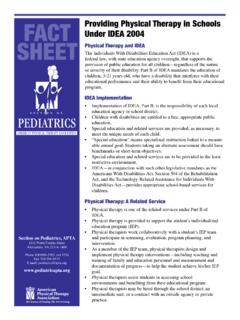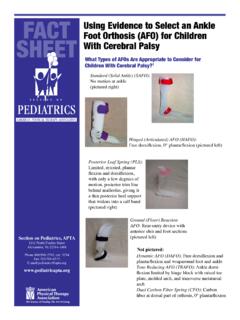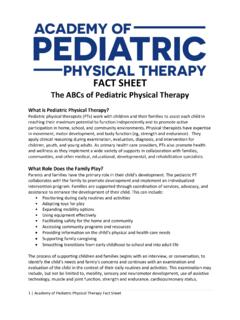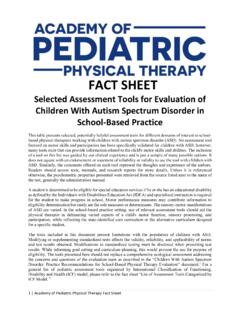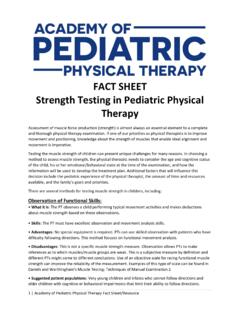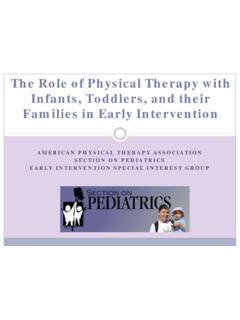Transcription of Spinal Muscular Atrophy Fact Sheet - PediatricAPTA.org
1 FactSheetSection on Pediatrics, APTA1111 North Fairfax StreetAlexandria, VA 22314-1488 Phone 800/999-2782, ext 3254E-mail: Muscular AtrophyWhat Is Spinal Muscular Atrophy (SMA)? SMA is a genetic disease that results in degeneration of the anterior horn cells and muscle weakness. SMA is the leading genetic cause of death among infants and toddlers. While some symptomatic treat-ments are available, there is no specific treatment for the disease itself. Disease PresentationSMA can present at any age with acute onset of motor weakness and loss of function. Proximal limbs, trunk, and intercostal muscles are most affected, with the diaphragm being relatively spared. The initial period of acute weakness is followed by a prolonged plateau during which muscle strength and function may be stable. Tremor and fasciculations are often seen in the fingers and tongue. Cognitive function of children (or individuals) with SMA is typically normal.
2 Some individuals with Type I SMA may have cogni-tive issues secondary to hypoxic injury. There is often a striking discrepancy between alertness and the ability to move in the more severe forms of Disease ClassificationThere are 3 types of childhood onset SMA, which are classified by the maximum motor skill attained: SMA Type I (Werdnig Hoffman Syndrome, acute SMA, infantile-onset SMA): Most severe type; children do not attain the ability to sit without assistance. It is also the most common type of SMA; occurring in up to 60% of SMA births (ICD-9 code: ) SMA Type II (intermediate SMA, juvenile SMA, chronic SMA): Intermediate form; children achieve the ability to sit and may stand with support at an early age, but they do not walk without braces or assistance (ICD-9 code: ) SMA Type III (Kugelberg-Welander Syndrome): Mildest form; children achieve the ability to walk without bracing or assistance at some point; however, loss of motor function (including ambulation) can occur (ICD-9 code: ) Figure 1.
3 Acquisition of Gross Motor Milestone in Controls Versus Infants With Spinal Musclar Atrophy1 Reprinted by permission of SAGE (Figure 1): Progressive weakness,2-8 leading to: A paucity of overall movement in those with Type I SMA Decreased active movement, with limited ability for antigravity movement in those with Type II SMA Decreased mobility Motor delay Early hypermobility with contracture develop-ment later in disease Poor head control common in those with Type I and some with Type II SMA Muscle fatigue9 Areflexia or hyporeflexia Axillary slippage Fasciculation of muscles, most common in tongue (in most cases noted visually as polyminimyoclonus in the tongue; may need ultrasound to visualize) and fingersPostural Compensations: Common resting posture: Excessive lower-extremity abduction and external rotation with hip and knee flexion; upper-extremity pronation with ulnar drift Kyphotic sitting posture in those that are able to sit Gower s maneuver in children with Type III SMA who are able to transition from floor to standingCardiorespiratory: Restrictive lung disease and respiratory in-sufficiency that presents initially as nocturnal hypoventilation10 At risk for cardiac involvement3,8,10,12 Cognitive and Sensory: Cognitive and Sensory systems are intact13At Risk For: Osteopenia,14 scoliosis,15-18 hip dislocation,19 falls and fractures3 Issues with nutrition and weight management8,20,21 Quick Facts SMA is the second most common neuromus-cular disease in childhood Recessive inheritance; parents are typically carriers and typical recurrence risk is 1 in 4 Incidence is between 1 in 6,000 to 10,000.
4 Carrier frequency 1 in 57 Age of onset is related to severity of pheno-type3,22 Type I typically presents in infancy (0-3 months) Type II after the onset of sitting (6-18 months) Type III (after 18 months) after the onset of walkingSurvival SMA is a result of homozygous deletion of what is called the Survival of Motor Neuron (SMN) 1 protein (Figure 2) Figure 2. Model of Normal and SMA Survival of Motor Neuron (SMN)1 Protein In the typically developing child, both SMN1 and SMN2 genes are present on chromo-some 5q13 and produce SMN protein. SMN protein is ubiquitously expressed and considered essential to life. It has been identified as a critical component of the RNA spliceosome and may have other cellular functions. In the child with SMA, the SMN1 gene is mutated and does not produce functional SMN protein. FSMA 2004. The SMN2 gene is a modulator of disease severity in SMA, and the child with SMA relies on the SMN2 gene to produce SMN protein.
5 While additional copies of SMN2 may allow for greater ability to compensate for the absence of SMN1, the relationship does not fully predict prognosis or outcome. The biological reason for motor neuron sensitivity to SMN protein depletion is still Is Dependent on Severity and Age of Presentation as Well as Treatment Choices3:SMA Type I: Survival is typically limited to 18 months with rare exceptions With mechanical ventilation (BiPAP, tracheos-tomy) and gastrostomy feeding, life expec-tancy can be extended23 SMA Type II: Variable survival that is dependent on respiratory compromise and support providedSMA Type III: Normal life expectancy SMA Is Not to Be Confused With: Muscular dystrophies and myopathies Congenital hypotonia Other diseases of the peripheral nervesDiagnostic Criteria Genetic testing (blood test): Homozygous deletion of exon 7 of the SMN1 gene3 EMG: Diminished compound motor action potential (CMAP), normal nerve conduction velocity (NCV)3 Muscle biopsy.
6 Grouped Atrophy (not required for diagnosis)2 Tests and Measures3,8 Tests of Body Functions and Structure: Manual Muscle Test24 Myometry25,26 Goniometry27 Pulmonary function tests10 Tests of Activity and Participation: Hammersmith Functional Motor Scale (HFMS)28,29 Modified Hammersmith Functional Motor Scale-Extend (MHFMS-Extend)30-33 Expanded Hammersmith Functional Motor Scale33,34 The Test of Infant Motor Performance Screening Items (TIMPSI)35 The CHOP Infant Test of Neuromuscular Disorders (CHOP Intend)35-36 Gross Motor Function Measure (GMFM)38,39 Timed tests of function (time to walk/run 30 feet or 10 meters; time to rise to standing from the floor; time to climb steps)39,40 North Star Ambulatory Assessment for SMA (NSAA-SMA)42 Motor-Function Measure (MFM)43,44 EK Scale45 6-Minute-Walk Test46,47 Activlim48,49 Pediatric Inventory of Disability Evaluation (PEDI)50 Children s Assessment of Participation and Preferences for Activities (CAPE-PAC)51 PedsQL 52-55 PedsQL Neuromuscular Module 56 InterventionWhy Is It Important for Children Diagnosed With SMA to Receive Intervention?
7 3,8 To foster and maintain movement and mobility to allow for independence and environmental exploration at younger ages, as well as to foster overall health and wellness and participation in activity, adapted sports, and recreation at all ages. Intervention Strategies Gait training for ambulatory patients to minimize safety risks and optimize energy expenditure57 An assistive technology evaluation to maximize activity and participation. This may include: Manual or power wheelchairs or scooters as early as 18 months to 2 years58 Standers or long leg braces to initiate standing in the second year for patients with SMA Type II59 Adapted computer access or switch toys as appropriate Equipment for ADLs, including environmental adaptations, bath equipment, and mechanical lifts Patient/caregiver education regarding handling, positioning, optimizing potential and safety, and preparing for changes with The maintainence of strength and the conservation of energy through exercise and activity (this includes play, aquatic therapy,61 hippotherapy, and developmental exercises).
8 The maintainence of flexibility through range of motion/stretching, positioning, bracing, splinting, standing programs, and serial casting. The faciliation of good posture, with appropriate seating to optimize alignment. The promotion of weight-bearing exercises to optimize bone health. Helpful Websites Families of SMA (FSMA): SMA Foundation: Muscular Dystrophy Association (MDA): SMA outcomes : TREAT NMD Registry of Outcome Measures (ROM): Swoboda KJ, Kissel JT, Crawford TO, et al. Perspectives on clinical trails in Spinal Muscular Atrophy . J Child Neurol. 2007;22(3):957-966. 2. Crawford TO, Pardo CA. The neurobiology of childhood Spinal Muscular Atrophy . Neurobiol Dis. 1996; 3(2) 3. Wang CH, Finkel RS, Bertini ES, et al. Consensus statement for standard of care in Spinal Muscular Atrophy . J Child Neurol. 2007;22(8) Swoboda KJ, Kissel JT, Crawford TO, et al.
9 Perspectives on clinical trials in Spinal Muscular Atrophy . J Child Neurol. 2007;22(8) Zerres K, Rudnik-Schoneborn S, Forrest E, Lusakowska A, Borkowska J, Hausmanowa-Petrusewicz I. A collaborative study on the natural history of childhood and juvenile onset proximal Spinal Muscular Atrophy (type II and III SMA): 569 patients. J Neurol Sci. 1997;146(1) Russman BS, Buncher CR, White M, Samaha FJ, Iannaccone ST. Function changes in spi-nal Muscular Atrophy II and III. The DCN/SMA Group. Neurol. 1996;47(4) Han JJ, McDonald CM. Diagnosis and clinical management of Spinal Muscular Atrophy . Phys Med Rehabil Clin North Am. 2008;19(3):661-80, xii. 8. Mercuri E, Bertini E, Iannaccone ST. Child-hood Spinal Muscular Atrophy : contro-versies and challenges. Lancet Neurol. 2012;11(5) Iannaccone ST, White M, Browne R, Russman B, Buncher R, Samaha FJ. Muscle fatigue in Spinal Muscular Atrophy .
10 J Child Neurol. 1997;12(5) Schroth MK. Special considerations in the respiratory management of Spinal Muscular Atrophy . Pediatr. 2009;123 Suppl 4 D Amico A, Mercuri E, Tiziano FD, Bertini E. Spinal Muscular Atrophy . Orphanet J Rare Dis. 2011;6 Iannaccone ST. Modern management of Spinal Muscular Atrophy . J Child Neurol. 2007;22(8) von Gontard A, Zerres K, Backes M, et al. Intelligence and cognitive function in children and adolescents with Spinal Muscular atro-phy. Neuromuscul Disord. 2002;12(2) Khatri IA, Chaudhry US, Seikaly MG, Browne RH, Iannaccone ST. Low bone mineral density in Spinal Muscular Atrophy . J Clin Neuromus-cul Dis. 2008;10(1) Sucato DJ. Spine deformity in Spinal muscu-lar Atrophy . J Bone Joint Surg Am. 2007;89 Suppl 1:148-154. 16. Granata C, Cervellati S, Ballestrazzi A, Corbascio M, Merlini L. Spine surgery in Spinal Muscular Atrophy : long-term results.


